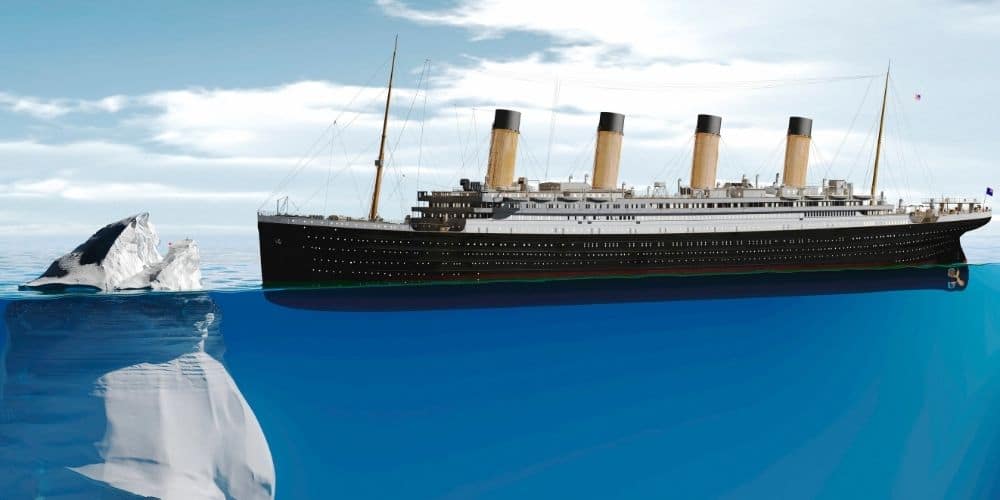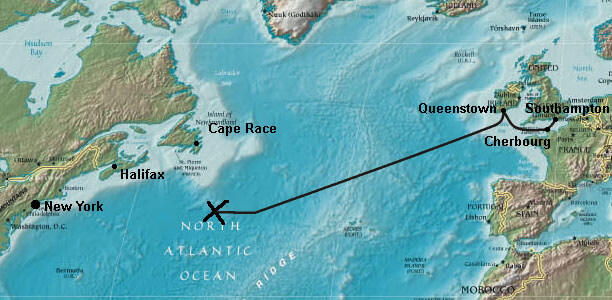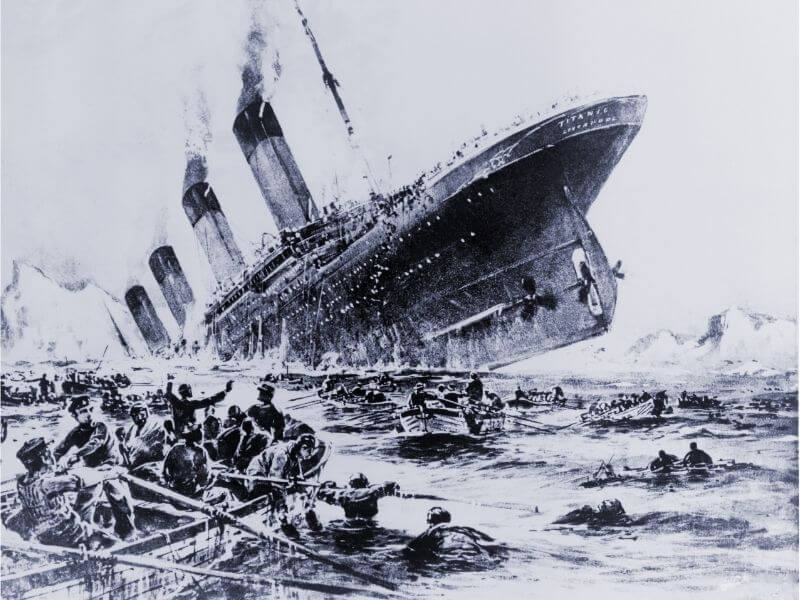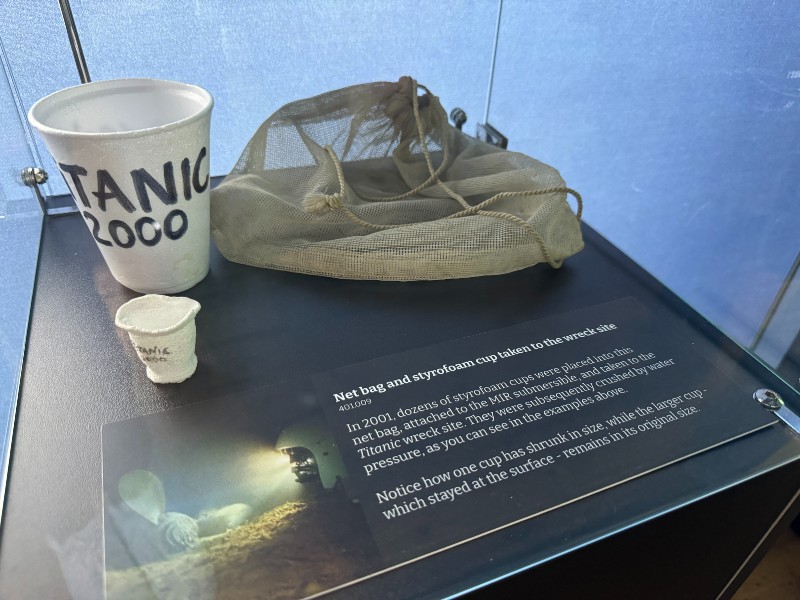The RMS Titanic is famous because it struck an iceberg and sank on its maiden voyage from Southampton, England to New York, USA.

The tragedy on April 15, 1912 resulted in the loss of over 1,500 lives, making it one of the deadliest peacetime maritime disasters in modern history.
To this day, people continue to be fascinated by the disaster and several have ventured down to the wreckage to see the ship’s remains.
But where exactly is the wreck of Titanic? This article explains…
Where did the Titanic sink?
The Titanic sank when it hit an iceberg in the North Atlantic Ocean, approximately 370 miles (600 kilometers) south-southeast off the coast of Newfoundland, Canada.
The exact coordinates where the Titanic struck the iceberg and sank are 41.726931° N, 49.948253° W.
You can see where the Titanic sunk on the map below. (You may need to zoom out).
Suggested read: Map of the Titanic Route
While several hundred people have ventured down in submarines to examine the wreck of the Titanic, doing so is notoriously difficult.
As well as the remote location, other challenges include the large area that the debris is scattered over, the extreme depth from the surface, the water temperature and the pressure.
We’ll explore each of these in more detail…

The Current Location of the Titanic Wreck
After the Titanic hit the iceberg, it continued to sail for about 10 to 12 miles (16 to 19 kilometres).
The Titanic hit the iceberg at approximately 11:40 pm on April 14, 1912, but it did not sink until around 2:20 pm on April 15, 1912, during which time the ship was slowly filling with water and sinking while still moving forward.
The ship broke apart as it sank and lighter debris was spread over a wide area by the currents.
The ship itself broke into two main pieces, which rest about a third of a mile (600 meters) apart from each other. But it’s estimated that smaller pieces of debris are distributed over an area of approximately 15 square miles.
The debris includes pieces of the hull, personal items from passengers, furniture, dishes, and other artefacts.

How deep is the Titantic wreck?
The wreck of the Titanic lies approximately 12,500 feet, or about 2.37 miles (3.81 kilometres), below the surface of the ocean.
This is roughly average in terms of how deep the world’s oceans are. However, some parts of the ocean are three times deeper than this.
This extreme depth, combined with the cold water temperatures and strong ocean currents, makes the site of the Titanic wreck particularly challenging to explore.
The water around the Titanic is freezing cold
The water around the Titanic’s final resting place is just above freezing, typically between -1 to 1 degrees Celsius (30 to 34 degrees Fahrenheit).
Because of the extreme depth, the water remains this cold all year round.
The water around the Titanic’s final resting place is consistently around or just above freezing, typically between -1 to 1 degrees Celsius (30 to 34 degrees Fahrenheit). This is due to the depth and location of the wreck in the North Atlantic Ocean.
Read more: How cold was the water when Titanic sank?
The pressure at the Titanic wreck site is incredibly powerful
At the depth of the Titanic, the pressure is approximately 380 atmospheres, or about 5,500 pounds per square inch (psi).
But what does that actually mean?
Well, water pressure is the force that the weight of water puts on things in it. The deeper you go, the more water there is above you, and the heavier that water is.
For every 33 feet (about the height of a three-story building) you go down in the ocean, the pressure increases by one atmosphere. One atmosphere is the amount of pressure we feel from the air at sea level.
So, let’s imagine stacking three-story buildings on top of each other. By the time you’ve stacked around 380 of these buildings (which is about how deep the Titanic is), the pressure is 380 times greater than what we feel at sea level.
That’s like having 50 elephants standing on top of a postage stamp!
This experiment demonstrates…
I recently visited The Titanic Exhibition in Bristol and there they had a styrofoam cup that was taken to the Titanic wreck site. As you can see from the photo below, it shrunk to much smaller than its original size due to the pressure of the water…

This is a tremendous amount of pressure, and it makes exploration and recovery operations at the Titanic wreck site so challenging and hazardous.
Only specially designed submersibles and equipment can withstand these extreme conditions and transferring from one submarine to another is not an option.
To conclude
The Titanic tragically sank in the icy waters of the North Atlantic Ocean, sinking to a depth of approximately 12,500 feet (2.37 miles or 3.81 kilometres).
The Titanic’s journey post-collision, the spreading debris field, and the resting place of the wreck itself provide a haunting testament to the magnitude of the disaster.

The challenges posed by extreme water pressure, freezing temperatures, and the vast depth underline the difficulties in exploring and preserving this historically significant site. As well as the obvious ethical considerations, these conditions mean that the Titanic will never be raised.
As we continue to learn from this catastrophic event, the Titanic’s final resting place serves as a poignant reminder of the power of nature and the importance of maritime safety.
Related Posts:
- Titanic Vs Modern Cruise Ships
- How Much Was A Ticket On Titanic?
- How Many Cruise Ships Have Sunk?
- Are There Human Remains In The Titanic?

Jenni Fielding is the founder of Cruise Mummy. She has worked in the cruise industry since 2015 and has taken over 30 cruises. Now, she helps over 1 million people per month to plan their perfect cruise holidays.


